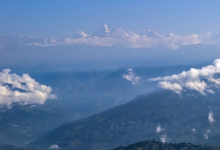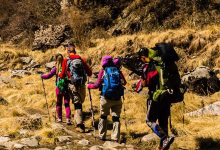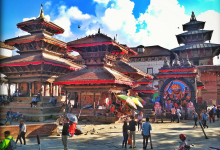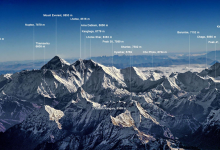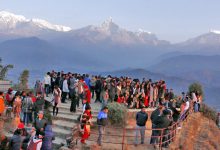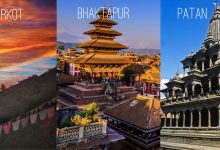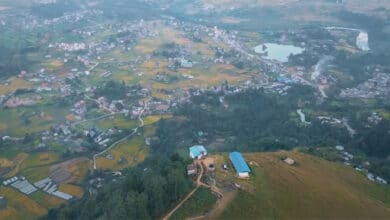Day Helicopter Tour to Everest Base Camp
Everest base camp helicopter tour with landing flight is the most exciting and thrilling lifetime experience in Nepal with the closest view of Mount Everest in a day from Kathmandu.
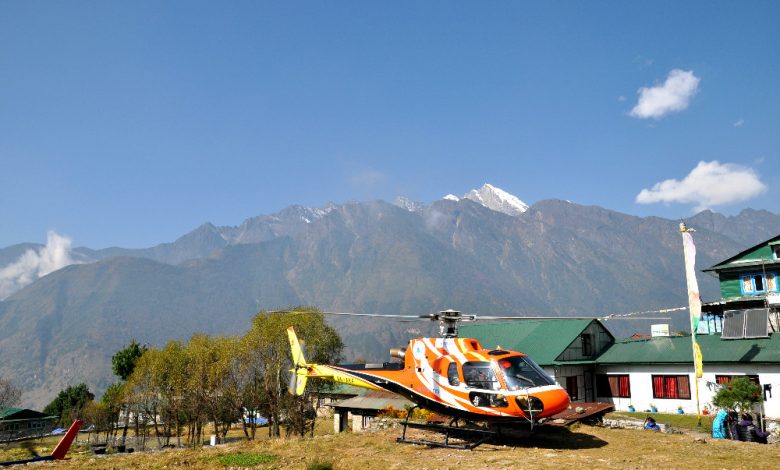
Spoil yourself with a thrilling helicopter tour over an Everest of breath-taking sights Nepal has to offer!. See Nepal like you never imagined with the ultimate Luxury sightseeing tour: a once-in-a-lifetime helicopter flight over the Mountain.
Day helicopter to Everest Base Camp will kick off from Kathmandu domestic airport. From Kathmandu, airport flight takes about 40-45 minutes to Lukla. The ultimate Base Camp Helicopter Tours give you some of the best mountain views and sceneries. You will be given 20 minutes at Syangboche (Hotel Everest view) to take tea/coffee or Breakfast. Syangboche has excellent views of Mt.Everest and its ranges.
Further, you can fly back to Lukla for fueling and then in Kathmandu to end. The Everest base camp helicopter flight goes over the Tengboche, Dingboche, Gorakshep, and Khumbu ice sheet to arrive at the Base camp of Mount Everest.
Know before you go
- If weather is not suitable, the flight may be rescheduled for the next day
- If the flight is cancelled, you can wait for next day
- Check all of your necessary things to carry
- Warm clothes and comfortable walking shoes are recommended
Everest Base Camp Helicopter Tour Facts
| Trip Duration | Day Helicopter Ride to Everest Base Camp |
| Tour Location | Kathmandu – Lukla – Syangboche – Kala Patthar – Kathmandu |
| Trek Grade | Luxury Holidays/Family Holidays/Couple Holidays |
| Highest Elevation | 5,644m / 18,519 ft | Kala Patthar |
| Pickup Points | Hotel in Kathmandu |
| Trip activities | Everest base camp helicopter tour with landing experience at Kalapather, stop one hour at hotel everest view for Breakfast time. |
| Group Size | 2-5 Persons. |
Highlights of Day tour to Everest Base Camp
- Blissful Helicopter flight from Kathmandu to the Everest.
- Visit amazing Sagarmatha National Park exploring the wilderness vast range of flora & fauna.
- You can have a privilege of landing at Kala Patthar, 5545 meters for 10 min.
- You get to fly over the major places of the Everest region within 4 hours.
- Get the panoramic views of the Himalayas of Nepal.
- You will dine in the Everest View Hotel, one of the finest high altitude hotel in the world!.
- Capture mesmerizing sunrise over the giant peaks
- Explore colorful prayer flags, monasteries, chortens reflecting Tibetan culture.
Romantic Everest Helicopter Tours for Two
If there’s a special occasion or anniversary on the horizon, a Everest helicopter flight for two is a great way to celebrate in style and create precious memories to live long after you’ve both landed. So, if you’re looking to make a big impression for your loved one with an unforgettable gift, check out our Everest helicopter tours to heighten the romance and show you care in the perfect way – available sunrise to sunset. You’ll thank us later.
- Pick up your Hotel at 6:00 AM, drive to the Kathmandu air terminal. Kathmandu to Lukla Airport: 45-minute ride (energizing time is 10-15 minutes at Lukla )
- Lukla to Kala Patthar: 25 minutes flight (landing time is 10-15 minutes)
- Kala Patthar to Syangboche (Everest View Hotel): 12 minutes (landing time is 30 minutes for breakfast)
- Syangboche to Lukla to Kathmandu: 1 hour 20 minutes.
- Get from the air terminal and move to your lodging in Kathmandu.
- Arrival and departure transfers to and from Kathmandu International Airports.
- Helicopter seats 5 people maximum in one Helicopter.
- Airport Boarding Pass and taxes.
- Oxygen for quick evacuation if required in Helicopter.
- 1 Hour break at Everest View Hotel.
- Helicopter cost for the flight.
- 10 to 15 Minutes of Break at Kalapathar.
- Government Tax & Fuel Surcharges.
- Nepal entry visa fees
- All kind of beverages (coke, beers, water etc).
- Tips and Gratitude.
- Everest entry permit fees.
| NO.OF.PERSON | AVAILABILITY | USD PRICE | INR PRICE |
|---|---|---|---|
| 2-4 | Guaranteed | USD 1350 | INR 75340 |
| 5-8 | Guaranteed | USD 1260 | INR 68740 |
| 9-15 | Guaranteed | USD 1160 | INR 61450 |
Do I need a visa? And what about passport requirements?
What are the best seasons for Everest Helicopter Tour?
How much does it cost to hire a helicopter in Everest base camp?
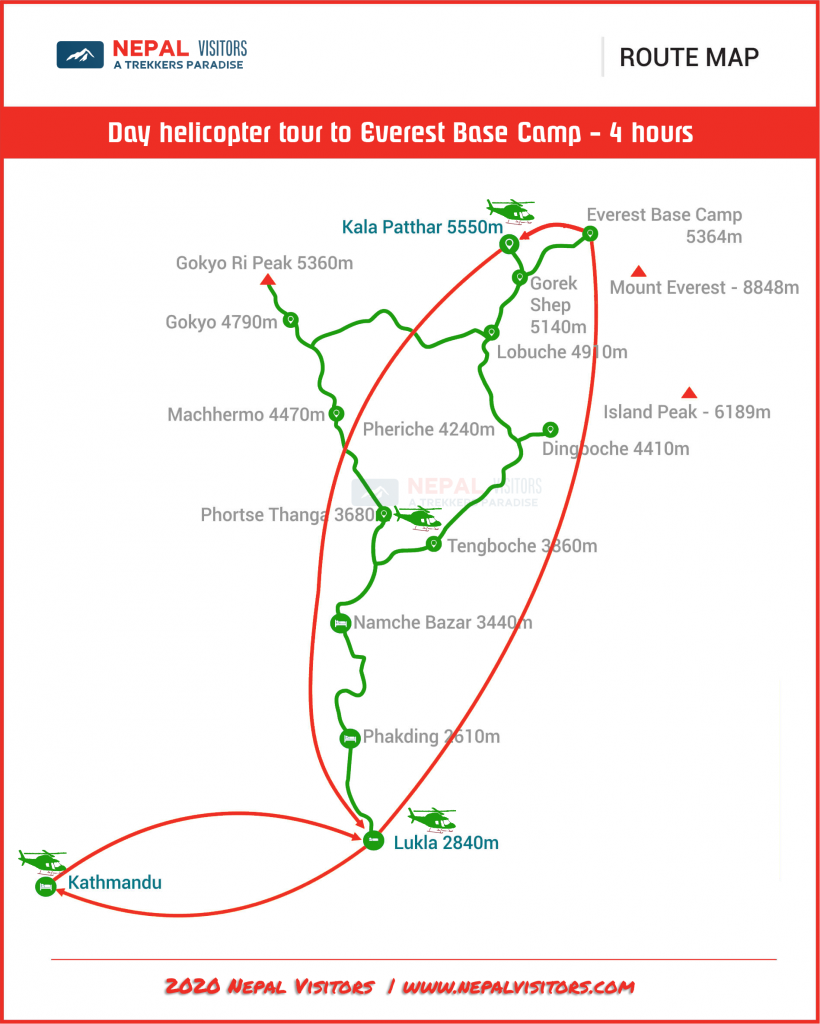
Safety for Everest Base Camp Helicopter Tour
Some of the safety rules that you need to know the most are as follows:
- Do not jump on and from the helicopter
- Do not change the seats while a helicopter is flying.
- Do not spit from a helicopter
- Do not disturb the pilot
- Carry the minimum luggage as possible
- Use cotton wools or cotton pads for the flight
- Do not walk alone along with the helicopter stop points
Thus, these are the things to remember during this chopper flight to Mount Everest Base camp and Kala Patthar.
The Luxury Trip | Everest Base Camp Heli Tour
Things to Carry during One Day EBC Helicopter Tour
It is always an essential factor to be on the safe side during the helicopter flight tour to EBC, and all the other helicopter tours in Nepal. Some of the things to carry for this Heli ride are as follows:
- Good Camera or Mobile Phone (Best Quality)
- Sunscreen and skin/lip balms
- Warm clothes blocking wind and cold (long-sleeves)
- Sunhat to protect from sunburn (needed during the breakfast in Hotel Everest View)
- Day backpack
- Mineral water (maximum 2 Bottles)
- Light snacks, dried fruits or some chocolates
- Some cash, in case you want to buy something
Thus, these are some of the necessary things to carry during the one-day EBC helicopter Tour.
Getting travel insurance
It’s always better to be safe than sorry. Especially for an intense experience like helicopter tours, I recommend purchasing travel insurance for your own peace of mind. There has been numerous insurance company of choice because of their comprehensive health coverage with 24/7 medical emergency assistance. As well, the process to making claims is super easy and smooth!
Helicopter Models For Flights
AS 350B series manufactured by French company Airbus (formerly known as Eurocopter). The interiors are roomy and spacious and can seat up to 5 passengers (excluding the pilot) comfortably. These lightweight helicopters are ideal for mountain flights and can land up to at an altitude of 23,000 feet. At high altitude, the choppers can manage to carry only 3 passengers per flight.
The most weight allowed in the Syangboche to Kalapathar/ Everest base camp is 250KG. Hence, as the weight limit exceeds, the helicopter needs to take turns. The turns for a shuttle from Syangboche – Everest base camp – Kalapathar – Syangboche. We can accommodate 2-3 travelers at a time in one shuttle.


